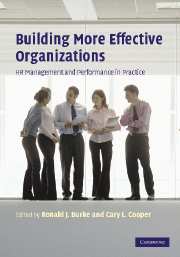Book contents
- Frontmatter
- Contents
- List of figures
- List of tables
- List of contributors
- Foreword
- Preface
- Acknowledgements
- Part I Building more effective organizations
- Part II Enhancing individual health and performance
- Part III Enhancing organizational health and performance
- Part IV Transforming organizations
- 12 Making it better – achieving outstanding performance in manufacturing organizations
- 13 Culture change in a financial services organisation
- 14 Building the sustainable organization through adaptive, creative coherence in the HR system
- 15 Be in to Win – from absence to attendance in Royal Mail Group
- 16 Transforming a company into a community
- Index
16 - Transforming a company into a community
Published online by Cambridge University Press: 05 June 2012
- Frontmatter
- Contents
- List of figures
- List of tables
- List of contributors
- Foreword
- Preface
- Acknowledgements
- Part I Building more effective organizations
- Part II Enhancing individual health and performance
- Part III Enhancing organizational health and performance
- Part IV Transforming organizations
- 12 Making it better – achieving outstanding performance in manufacturing organizations
- 13 Culture change in a financial services organisation
- 14 Building the sustainable organization through adaptive, creative coherence in the HR system
- 15 Be in to Win – from absence to attendance in Royal Mail Group
- 16 Transforming a company into a community
- Index
Summary
At their second annual retreat, 250 leaders of the Asia region of a multi-national food business spent two to three days in ashrams, spiritual centers, microenterprises and charities in India to learn about community life. There they tended the needy, offered what help they could, and asked swamis, spiritual leaders, community entrepreneurs, and dabawhallas how they could accomplish so much with so few resources. These business leaders were learning what a true mission is and concluded that they needed to find a “higher purpose” for their business.
The intent of visiting these communities was for these Asian business leaders to experience communal living in its many forms and deepen their collective understanding of the ingredients of community life (McMillan and Chavis, 1986). The expectation was that as the leaders informed themselves about the people and circumstances of the communities they visited, they would also ponder the meaning and implications for their own leadership body and business.
The idea of running this company as a community had been an aim of the new chairman since he took over the region two years prior. To this point, the region had operated as a confederation of fifteen national operating companies with a strategic regional overlay and managing board. He wanted to connect the senior leaders of national companies together more closely and to include the next layers of country marketers, supply chain managers and staff in strategic discussions and operational reviews of regional business. Behind this was a perceived need and personal desire to build the capacity of this entire leadership body 250 plus, to think and feel together, that is, to operate as a community of leaders.
- Type
- Chapter
- Information
- Building More Effective OrganizationsHR Management and Performance in Practice, pp. 353 - 370Publisher: Cambridge University PressPrint publication year: 2007



